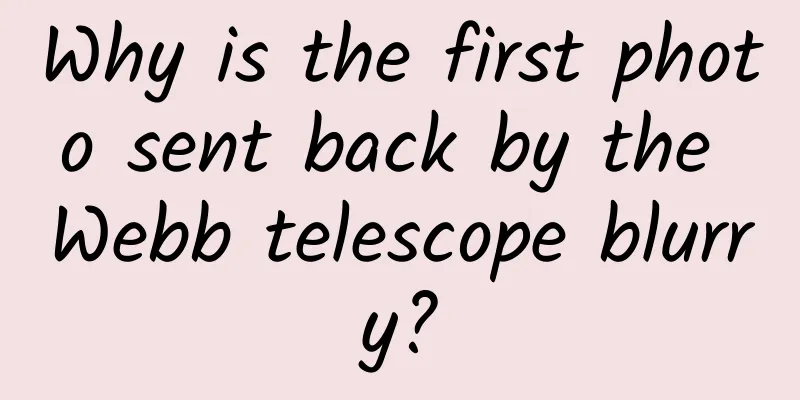Why is the first photo sent back by the Webb telescope blurry?

|
The Webb Space Telescope (referred to as "Webb" in this article), which was launched on December 25, 2021, arrived at the second Lagrange point 1.5 million kilometers away from us on January 24 this year after a month of travel, entered the predetermined orbit, and soon transmitted back the first photo it took. NASA released this photo, which is just a group of blurry stars. In addition, it sent back a selfie of itself, which is also blurry. (See the picture above, this is a combination of two photos by space-time communication) Some friends may be disappointed after seeing this picture. After decades of development, the launch of the Webb has been repeatedly postponed, and it has boasted a lot. Is this the only thing it can do? Is it worthy of the $10 billion investment? Don't worry, let me explain the origin of this photo, and then you can express your feelings. This bunch of starlight is actually just a star The starlight photo sent back by Webb has 18 bright spots (two of which may be squeezed together), which look like 18 planets, but are actually just one star. This star is located in the Ursa Major constellation, about 258 light-years away from us, and is called HD 84406. In fact, this is a test shot of Webb, and it is not a single shot that looks like this. Webb worked for 25 hours after waking up and took more than 1,500 photos to combine into this one. The reason why this star was chosen as the first photo it took is that this star is very bright, with an apparent magnitude of 6.9, right at the mouth of the Big Dipper, and the distance between the apparent distance and the flat mouth of the spoon is about one spoon mouth (see the picture above). The brightness of stars visible to the naked eye in the night sky is measured in magnitude. The larger the value, the dimmer it is, and the smaller the value, the brighter it is. There are also negative numbers, and the more negative, the brighter it is. The human eye can only see the dimmest star of magnitude 6, and it cannot see stars above magnitude 6. Therefore, the human eye cannot see the star HD 84406, but it is a piece of cake for the Webb telescope. However, the Webb telescope still has "astigmatism" and has not yet corrected its "vision", so it needs to find a star for reference. This star cannot be too dark or too bright. The brightness of this star called HD 84406 just meets the requirements, and there is no interference from other celestial bodies around it. It is the best choice for correcting its "astigmatism". The reason why Webb is "astigmatism" is that its main mirror is composed of 18 small hexagonal mirrors, with a diameter of 6.5 meters and an area of 25 square meters. Such a large mirror cannot be launched directly, and needs to be folded and put into a rocket, and then unfolded again after launching into space. This will cause the focal length of each mirror to deviate, and the stars will not be focused on one point, so it will have to be re-adjusted. These small mirrors can rotate independently, and the adjustment accuracy can reach the nanometer level, which is about one ten-thousandth of a hair. However, there must be a reference for adjustment, so the purpose of photographing this star called HD 84406 is to serve as a reference for adjusting the mirror. The photo with 18 bright spots sent back now was taken by each small mirror of the Webb primary mirror. According to the angle of each mirror shining on the star, scientists and the telescope's automatic calibration device can adjust these lenses and finally form a focus, eliminating the "astigmatism". The selfie was taken by a camera mounted on a secondary mirror mounted on a 8-meter-long bracket extending from the primary mirror. The selfie has a small mirror that shines brightly because it is reflecting a star. This selfie is not a conceited photo of Weber, but it serves as a very important reference for the adjustment. There may be many more such selfies until the adjustment is in place. The scientists who developed and managed Weber were delighted to get these two seemingly insignificant photos, because it symbolized that Weber was not only accurate, but also opened its wings and eyes. Once the adjustment is completed, it will have a sharp gaze and tell the unknown secrets it sees to humans. How powerful is the Webb telescope? The full name of "Webb" is the James Webb Space Telescope, named after James Webb, the second director of NASA. James worked at NASA from February 14, 1961 to October 7, 1968, and made outstanding contributions to the space industry of the United States and even mankind, especially the "Apollo" moon landing program in the 1960s. In order to commemorate this aerospace pioneer who died in 1992, this top space telescope was named after him. "Webb" is the successor to the Hubble Space Telescope (sometimes referred to as "Hubble" in this article), which has been in service for 30 years and is about to be retired. It is a more powerful space telescope after "Hubble". Its aperture is 2.7 times that of "Hubble" and its area is more than 5 times that of "Hubble", but its mass is only 6.5 tons, which is more than half of the 11 tons of "Hubble". The biggest feature of this telescope is that it can observe in the infrared band. Any celestial body may not emit visible light, but it will definitely emit infrared light. As long as there is a little bit of thermal motion, it will be observed by "Weber". This requires the telescope to operate in an environment close to absolute zero (-273.15℃), because even a little bit of thermal radiation will seriously interfere with infrared observations. Therefore, the Webb telescope not only has to work in the cold space, but also has to keep its mirror facing away from the sun. To avoid the heat radiation from the sun, Webb not only has to hide in the shadow of the earth, but also has a thick multi-layered "sunshade" that is a bit like a huge open book, blocking the sun and the telescope, so that the main and secondary telescopes of Webb can work completely immersed in the cold darkness. In addition, it is necessary to use its own liquid helium to cool its own equipment. By radiating into space, the temperature of the main mirror can be reduced to below -223°C, the near-infrared instrument can be cooled to below -233°C, and the mid-infrared instrument (MIRI) can be cooled to below -266°C! After Webb was launched into the space environment, it gradually unfolded its folded mirror during its speeding journey. After reaching the second Lagrange point target orbit on January 24, 2022, it began cooling its key systems. It is now gradually approaching the operating temperature, but there is still some gap. The development and launch of Webb is more cautious than any other spacecraft in the past, and the investment is also huge. This space telescope was jointly developed by NASA, ESA and the Canadian Space Agency, and it took 25 years of meticulous work before it was finally launched into space. "Webb" entered the development stage through bidding in 1996. The investment budget increased from the initial US$500 million to US$8.8 billion in 2013 after more than a decade of continuous increase. The launch time was originally scheduled for 2007, but it was postponed again and again until the end of 2021 when it was successfully launched into space. In the end, the total cost of Webb has exceeded 10 billion US dollars, which is five times more than the approximately 2 billion US dollars spent on the Hubble telescope. Of course, after the Hubble telescope was launched, five groups of astronauts were sent to replace parts or perform maintenance. Together with the subsequent maintenance costs, the total investment is no less than 5 billion US dollars. But compared with Webb, it is still a small matter. The reason why Hubble can be well maintained is that it is in low Earth orbit, with an altitude of only 575 kilometers. The Webb telescope is operating at the second Lagrange point, 1.5 million kilometers away from us, and it is basically impossible to maintain it. Therefore, once it is launched, it can only be a one-shot operation. This is also the main reason why the Webb telescope has been repeatedly postponed and continuously improved. The launch of the Webb telescope has no way back, it must be launched with one shot, otherwise the $10 billion will be wasted, and not even a bubble will be left. After 25 years of research and development, the launch should be full of confidence, but it is still very scary. If there is a little accident, such as a failure to change the orbit or a micrometeorite impact, all the previous efforts will be wasted. Fortunately, everything went well. Therefore, although the photo taken was only a calibration picture, the scientists who developed and managed "Weber" were also ecstatic, because this photo symbolized that "Weber", which is far away from humans and carries great hopes for mankind, has been successfully in place, "feels" good, and is waking up and preparing for work. What are the hopes for the Webb telescope? What people want to know most through Weber is the origin of the universe, which is the root of all things and the most fundamental question of where human beings come from and where they are going. Weber may become the eyes of human beings to unlock the ultimate secrets of the universe. Specifically, its main task is to investigate the residual infrared evidence of the Big Bang and observe the state of the early universe. Based on this goal, the Webb telescope will focus on scanning and spying deep space in the dark and cold space, completely shielded from sunlight, looking for clues to the early birth of the universe. Some scientists predict that with the ability of "Webb", it will be able to see the first ray of light after the Big Bang. This ray of light occurred 380,000 years after the Big Bang, when electromagnetic waves decoupled from the high temperature and high density state at the beginning of the Big Bang. The Hubble Telescope, which was launched 30 years ago, has discovered that the farthest galaxy is 13.4 billion light-years away from us. If the Webb telescope can capture this ray of light, it will see starlight 13.82 billion light-years away, and will lead mankind into the time tunnel of the entire universe. Scientists will be able to peek at the formation process of the first atom after the Big Bang, the appearance of the first nebula, the formation process of the first galaxy and the first star, and trace back to the appearance of the universe today. Perhaps they will also be able to solve the mystery of dark matter and dark energy. Of course, the various cosmic phenomena such as galaxies and celestial bodies that the Hubble telescope can discover are no problem for the Webb telescope. During its service period of at least 10 years in the future, it will discover more cosmic secrets and enable humans to have a more thorough understanding of the universe and its own solar system. Weber has just woken up, stretched out its body and is opening its confused eyes. After it cools down and focuses, it will surely bring surprises or astonishments to humans one after another. What do you think? Welcome to discuss, thank you for reading. The copyright of Space-Time Communication is original. Infringement and plagiarism are unethical behavior. Please understand and cooperate. |
<<: When one type of pasta falls from grace, another type of pasta rises
Recommend
[Case] UHome Hotel Operation and Promotion Case
A few days ago, I went to Thailand and wandered a...
Tencent suddenly lifted restrictions on WeChat: Google and Bing can search for public account articles, but Baidu cannot
In the era of mobile Internet, many apps have beg...
A man vomited for more than a year and had a craniotomy to remove parasites. The cause turned out to be this kind of hot pot that everyone eats...
Speaking of bullfrog, it is a favorite on many pe...
Whose monkey has a "sun" on his head?
There are so many little moving suns here? Oh no!...
These bad habits can lead to scoliosis, parents of primary and secondary school students must be vigilant!
《Cotton Swab Medical Science Popularization》 Capi...
What's worth buying product analysis report
On July 15, 2019, " What's Worth Buying ...
How to promote on Bilibili?
Bilibili , a video content community that started...
The "free traffic" policy for the entire network is harmful to both others and ourselves
With the advent of 4G, there has been a lot of di...
Text layout performance improved by 60%, Inline Text technology principle and implementation
Alipay clients have a strong demand for dynamics....
Xiaohongshu’s methodology for building a brand
A friend asked me: I have several brands operatin...
Put a Band-Aid on your injury? Don't do it in these situations. Not only is it useless, it may also...
gossip "Band-Aid is a magical tool for traum...
Why do ducks just stand there in the rain without moving when it rains?
When it rains in the summer, most people will rus...
The more the price is reduced, the less it sells. The market share has dropped by 13% in the first half of the year. Japanese cars have entered garbage time in China ahead of time.
How much does a Nissan Sylphy cost? At least tens...
Vulgar content can still be found! Is the App's "Teen Mode" just for show?
How effective is the anti-addiction "teenage...
Jimifeng Network: What should you pay attention to when creating an entry in Baidu Encyclopedia in order to get it approved?
When editing an encyclopedia entry, you need to p...









